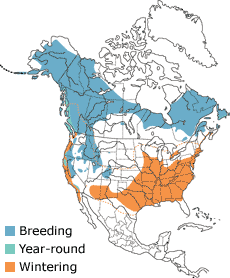 Fox Sparrow, red form
Fox Sparrow, red form Figure 1. Distribution of the Fox Sparrow. This species winters very locally north and south to the dashed line. See text for details.
Figure 1. Distribution of the Fox Sparrow. This species winters very locally north and south to the dashed line. See text for details.The Fox Sparrow is a common but shy inhabitant of streamside thickets and chaparral across the northern boreal and western montane regions of North America. Habitat preference varies geographically, with each of the major groups preferring nesting locations with different plant communities. Fox Sparrow populations also vary in migratory distance and route; individuals nesting in the Sierra Nevada of California migrate only short distances, mostly altitudinally, while those from Alaska migrate long distances, with some traveling over open ocean. Populations also vary in their song types; while northern and eastern Fox Sparrow populations sing 1 or 2 song types each, western populations sing 3 or 4; commonly heard calls (contact notes) also vary geographically, differences largely correlating with the major groups. This sparrow's large geographic distribution, relative abundance, and extreme geographic variation in plumage, morphology, habitat preference, migratory behavior, and vocalizations make it ideal for comparative evolutionary studies. While several modern studies have focused on Fox Sparrow systematics, song, and migration, many aspects of the life history of this species remain unknown. Its shy habits and preference for dense vegetation have made the collection of life-history data difficult.
The four groups of the fox sparrow are: Red Fox Sparrow (iliaca group); Sooty Fox Sparrow (unalaschcensis group); Slate-colored Fox Sparrow (schistacea group); Large-billed Fox Sparrow (megarhyncha group).
 Typical plumage characteristics of the four major groups of Fox Sparrow, as illustrated by John Schmitt.
Typical plumage characteristics of the four major groups of Fox Sparrow, as illustrated by John Schmitt.It is obvious from this description that the fox sparrow has adapted in very visible ways to the different habitats across its extensive range. Since the manifestations of these adaptations (color, beak shape, body metrics, enzymes) are genetically constant enough to use as a basis for recognizing separate species, it is clear that the responses of this bird to the different environmental challenges in the different locations where it lives have resulted in genetic divergence among the populations, i.e., evolution. Similar genetic changes in other species can be expected to occur wherever its constituent populations adapt to different local environmental conditions across its geographical range.